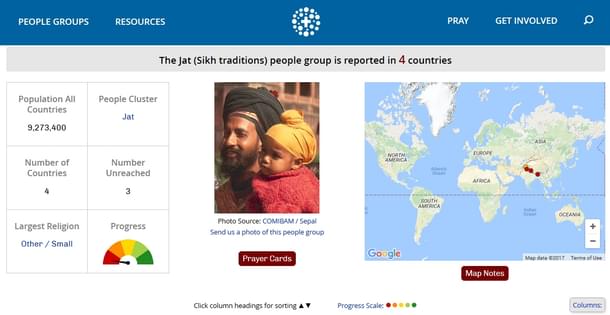Politics
Harvesting Souls In Punjab: How The Evangelical Ecosystem Targets Sikhs
Aravindan Neelakandan
Jul 01, 2017, 06:58 PM | Updated 06:58 PM IST
Save & read from anywhere!
Bookmark stories for easy access on any device or the Swarajya app.


Four Sikhs – Paramjit Singh of Amritsar, Simarjit Singh and Jaspal Singh of Sanghe village, and Manavdeep Singh of Deenewale village – were arrested on 27 June for making “derogatory remarks against Jesus Christ”. The Christian protestors indulged in violence, pelting stones on buses and burning tires on the national highway. After an orgy of mob violence, they gave a two-day ultimatum to the administration to arrest the Sikhs, who they claimed had “blasphemed against” their deity Jesus.
After the arrests of the Sikhs, “bishop P J Suleman, who was flanked by representatives of various Christian organisations, including Punjab Christian Movement (PCM), said they were satisfied with the police action in this case” (‘Christians call off protests after arrests in video episode’, Indian Express, 28 June).
This is not the first time that the Christian community in Punjab has angrily reacted to the “blasphemy” of Sikhs against their god. On 22 May 2001, Satnam Singh, a 70-year-old lawyer, was arrested for his book on Sikhism. It had a chapter on Jesus in which the Christian deity was depicted in an unfavourable light. That was in the 1999 edition of the book. In the 2001 edition, the objectionable passages had been edited out. Even then the Christian leaders were not satisfied. They demanded the arrest of the author. Satnam Singh was arrested and, after he got bail, later offered to apologise, though the Christian leaders questioned his sincerity (Christianity Today, 1 June 2001).
The confrontation between Sikhism and Christianity is neither sudden nor relegated to isolated events. In fact, the reaction of Sikhs, which had attracted media attention in a highly unfavourable manner, is the result of Christian invasion and evangelical war on Sikhs that spans the last two centuries.
Sabu Mathai Kathettu, a Christian evangelist from Operation Mobilisation (deceptively abbreviated as “OM”), published in 2009 a report assessing Christian evangelical work in Punjab. Published by one of the apex protestant institutions in India with global connectivity, the Indian Society for Promoting Christian Knowledge (ISPCK), the book provides not just a historical account but also the theological position and methodology for conversion of Sikhs to Christianity. It shows the kind of monumental global adversary against which are pitted the rural Sikhs of Punjab.
The book’s author is well aware of the incompatibility of the fundamental tenets of Sikhism with those of Christianity. This has even created a hurdle in approaching the Sikhs, he points out:
(The missionaries) preached that all people are sinners, and Christ is the true Saviour. The concept of all people as ‘sinners’ was objected to by the Hindus and Sikhs because it was different from their philosophy. For them it is difficult to recognize that they are sinners!p 73
Note the exclamation point, as if it is a natural thing for people to think of themselves as sinners. And the Sikhs and Hindus are shown as if they have some learning disability – difficulty in recognising that they are sinners.
The Sikh concept of god is also contradictory to the Christian concept of god. For Guru Nanak, the god is “loving and gracious but He is never angry or shows wrath towards humankind”. In contrast, when the Christian god’s “righteousness confronts human sinfulness it becomes wrath because God is holy and abhors sin”. Further, Sikhism dismisses “the uniqueness of Jesus as the Son of God and the only way to God”. In addition, the book says “the Sikh doctrine of Ek Onkar, the Absolute Oneness, rejects the Biblical concept of Triune God” (p 113).
So evangelism is needed. The book clearly states the obvious that all humanitarian work done by Christians is only a means for conversion. However, despite British-engineered famines ravaging Punjab, they could not attain much success, so they changed strategies.
Evangelism was the ultimate goal of mission societies and ministries such as education, medical care and literature were seen as channels towards evangelism. ... Progressively, the missionaries changed their strategy and adopted the ingenious methods to present the gospel.p 73
Mathai says that still “the missionaries did not have a proper strategy to reach the Sikh community”. So they decided to convert the ‘high castes’. Mathai unwittingly busts a big missionary propaganda line that missionaries were genuinely attracted towards the poor and the downtrodden. They actually went for the so-called upper castes. When they could not convert them, they turned to the so-called lower castes. No humanitarianism here, only a change of strategy.
They realized the importance of reaching the Hindu high caste people in Punjab. Stock says that the Christian missionaries were convinced that winning the high caste was the key to evengelising the country as a whole. ... Later the missionaries turned to Chamars and Mazhabi Sikhs of the lower caste.p 75
Even here there was a failure. The converts were seen as kind of collaborators with the British, people who had gone out of Indian culture. In a revealing line, Mathai writes that “it was evident in 1857 when the Indian Mutiny broke out...” (p 77). It is revealing for the use of the term ‘Indian Mutiny’. It shows from which point of view a modern evangelist born in independent India approaches the problem.
When it comes to independent India, Mathai writes how evangelists are using the modern visual communication system. The Indian state machinery is also co-opted in this evangelical war against Sikhism.
Christian Broadcasting Network (CBN) is screening gospel programmes through the national channel Doordarshan in Hindi. In Punjab churches and mission agencies use Jesus or Dayasagar films in outreach programmes. Sikhs respond to these programmes well. At present a few fundamental Hindu and Sikhs are fiercely opposing the screening of these films.p 97
Still there are problems. They are not winning the conversion battles. Mathai points out the possible reasons and starts suggesting remedies.
The pattern of worship, customs, and church buildings are not inculturated and are the same as the missionaries left behind. Therefore the Sikh community does not understand the core of the gospel message. The churches of Punjab should modify their mission strategy to reach the Sikhs effectively. The gospel of Christ should be incarnated in the context of the Punjab. The pattern of the church and worship should be inculturated in a way the Sikhs can understand.p 100
In enumerating the hurdles, one is frighteningly interesting. The Sikhs are successful, self-confident and content, and there Mathai sees a problem.
Most Sikhs are well settled and secure as they feel satisfied with their own religion. Wealth is a great hindrance to them for accepting salvation. ... Because of wealth they have developed strong personality and personal security that has instilled in them a kind of pride that they can survive anywhere in the world. The Christian worker, or the church, must make a strategy to witness to the Sikhs regarding their appetite for the material things.p 101
One is left to wonder what kind of a religion wants to destroy the self-confidence and success of a community of people so that it can spread itself.
Then he details how to evangelise through inculturation – which is essentially creation of theological confusion in a community.
... for effective inculturation, satsang style of worship services should be conducted in the local languages with kirtans accompanied with local music. Also singing Bhajans should be included in worship. Bhajans and Kirtans are the appropriate method for communicating the Word of God effectively to the Sikh community. ... Every morning and evening the scripture should be broadcasted from the church as is done in the Gurudwara.In such cases laws regarding the use of microphones and loudspeakers should be adhered to in government restricted areas. ... And after the worship service the believers should share fellowship around a communal meal like the langar.p 107
Note the intentional confusion of symbols and spiritual entities exclusively rooted in Sikh culture and religion. Note the creation of competitive use of loudspeakers that can create social strife. And note the caution so as to escape government monitoring. The methodology of blatant deception continues.
Christian workers should also learn and use Punjabi terms. The church can be called Kristh Gurudwara or any appropriate words can be used. ... Also the term ‘pastor’ or ‘priest’ can be replaced by ‘Granti’ or ‘Giani’. It is best for believers to be called Isa da Sikh.(p 108-9)
Even the life-cycle rituals are not spared.
The most important ceremony is that of pathul or baptism, usually administered at puberty. The initiate takes amrit nectar and is admitted to the Khalsa fraternity. The concept of pahul in Sikhism is similar to Christian baptism. Therefore the Pastor should be able to critically evaluate it and adopt the good elements of it.p 110
Note the condescending theo-supremacist tone. The pastor will critically evaluate and judge and adopt the ‘good elements’ in a ritual central to Sikhism. Lest we think the missionaries are indulging in crass deception, the usual tool of historiography that would do a Romila Thapar proud is employed to justify the evangelical deception. The Sikhs appropriated the Hindu festivals and we are doing the same to them.
The Sikh festivals are the best examples of inculturating the meaning of Hindu festivals into Sikh faith by their Gurus. The same way, the Christian missionaries can inculturate the Sikh festivals with Christian meanings.p 111
It is conveniently forgotten that Sikhs did not appropriate Hindu festivals with the ulterior motive of converting them. Neither did they appropriate nor did the Sikhs inculturate. The festivals have evolved in India with their own local narratives. There are no clever intentions or artificial instructions like the ones given here. They are symbols of pluralism that underline India’s spiritual cultural unity and not tools of expansionism.




Figures 1-4: Almost all Sikh communities are under the evangelical radar with shocking background work done on each of them. Note that in Pakistan, 60 per cent of Jat Sikhs have become Christian. Also remember that in the Joshua Project database, some Christian denominations like the Catholics are not considered Christian.
Then comes the ultimate appropriation – the fulfilment theology, which in the context of non-Christian faith says that the latter is spiritually deficient and that Christianity fulfils it. In doing this even the holiest aspects of Sikh spirituality are not spared.
The Christian worker must evaluate whether the concept of Sat Guru can be used or not. Also after a careful study the term Sat Guru can be adapted for Jesus as he is the only way to the Father. Jesus claimed himself as the truth, so he is the Sat Nam. ... the title Waheguru also can be adapted to accept Jesus. ...Therefore, Jesus Christ is the only Satguru who provides salvation and he can also be described as the fulfillment of Guru Granth Saheb.p 113
With such ammunition and foreign funds, individual cult-like churches have at last started mushrooming in the Punjabi villages. In 2011, Shafi Rahman reported in India Today how such independent churches are attracting huge foreign funds and are spreading across Punjab. These are radical churches and they have Taliban-like solutions for perceived social evils. Rahman gives an eye-witness account of how they work with the believers.
At Wanjawala near Amritsar, Prakash Messi, a borewell-operator-turned-preacher, holds his Sunday prayers in the living room of one of his parishioners. He asks a group of 25 men: “Alcohol is sin. What is the reward of sin?” They answer in unison: “Death”. The preaching is simple, the demands to the Lord are less complicated. “Jesus, son of Virgin Mary, make our journey on cycles and motorcycles safe,” prays Messi. The prayer group includes converted Hindus and Sikhs and even former Catholics.Shafi Rahman, ‘Freelancers of God’, India Today (30 April 2011)
With the ‘secular parties’ refusing to take note of this problem of conversion war unleashed on Sikhism, interestingly, only the Rashtriya Swayamsevak Sangh (RSS) has come forward to counter conversions with the media-maligned ‘Ghar Wapasi’ programme. On December 2014, RSS efforts led to the homecoming of 40 Mazhabi Sikh families at Jivan Singh gurdwara in Guru-ki-Wadali, Amritsar. However, these efforts are no match to the highly institutionalised, global, evangelical war apparatus which has been researching and developing its weapons of deceptive conversions, specially targeting the Sikhs for the last two centuries.
After the theo-institutional appropriation and foreign-funded evangelism, Christianity has started asserting itself as a political force which can unleash violence and effect censorship on the society. In 2016, Christian leader Imanul Rehmat Masih announced to the media that the actual Christian population in the state was 7-10 per cent instead of 1 per cent as reported in the government census (‘Census does not tell real population of Christians in Punjab: Leaders’, Hindustan Times, 5 September 2016). The demands of Christians as an aggressive political entity in Punjab are accelerating in an alarming manner.
The implications for the border state Punjab and Sikhs, who have traditionally stood as the barrier between expansionist monocultures and rest of India, becoming evangelised is severe for India as a nation and as a civilisation. Imagine a Christian movement consisting of converted Sikhs; then one can understand the gravity of the problem.
The frustration of the rural Sikhs against such a well-planned strategy and a global enemy is totally understandable. Today, the Punjab police has charged the Sikhs under Sections 295A (outraging religious feelings), 505 (for rumours) and 153A (promoting enmity between different groups) of the Indian Penal Code (IPC) against eight people. If that is what those frustrated, helpless individual Sikhs did, what is it that the church organisations have been doing to the Sikhs? Are they not ‘outraging religious feelings’ of Sikhs by appropriating their holiest of holies? Are they not ‘promoting enmity between different groups’ by indulging in nefarious conversion practices aimed to confuse common Sikhs?
Sikhs in Punjab have a battle on their hands – one of the toughest in their history of valiant struggle. The state government should recognise this and withdraw the cases against the Sikhs and enact laws that would curb the missionary activities in the state and proclaim them as anti-national and anti-humanistic.
Aravindan is a contributing editor at Swarajya.




